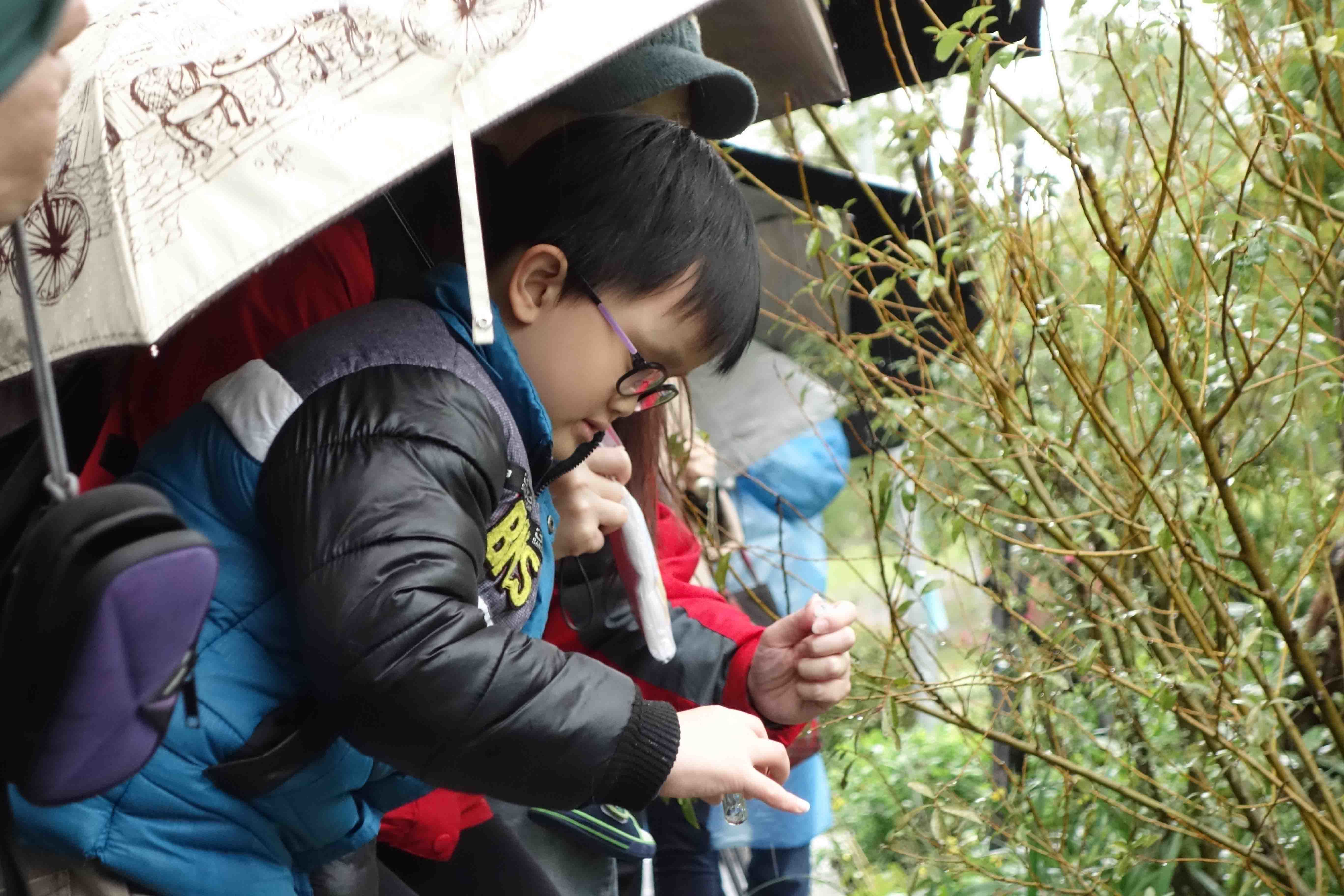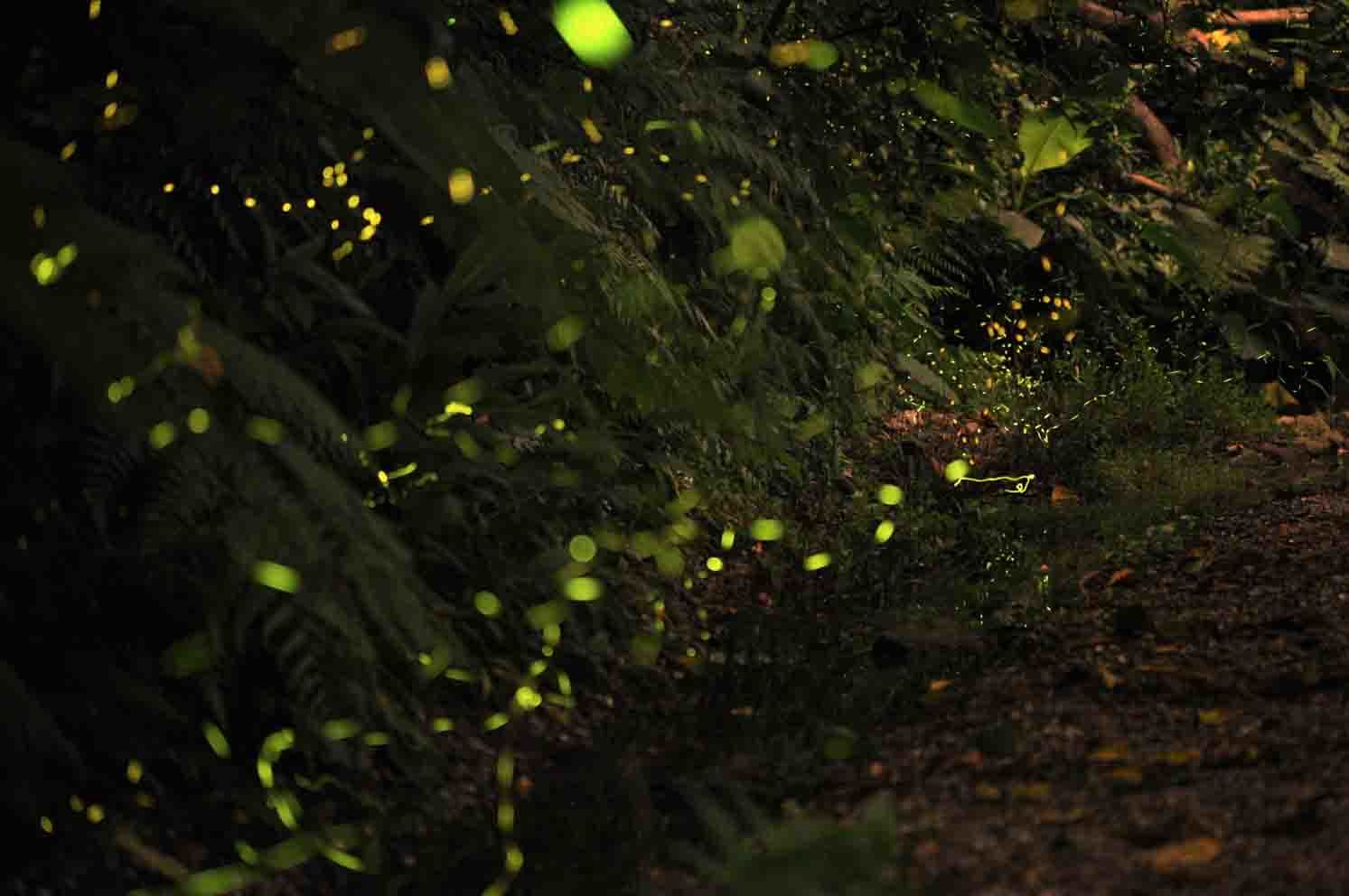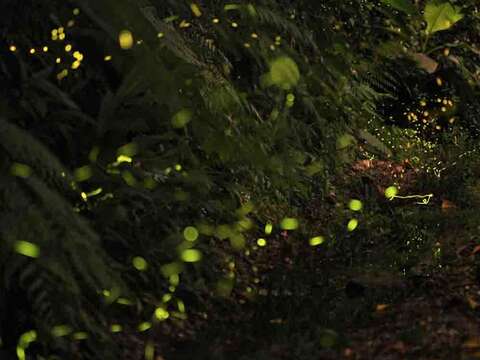Post date:2016-07-11
Updates:2016-08-23
1483
Article _ Lai Yixuan, Taiwan Ecotourism Association
Photos _ Wang Yijie, Taiwan Ecotourism Association, Damai Studio
Many Taipei residents are likely unaware that they can view fireflies within city limits. Firefly season begins in mid-April, during which the bioluminescent glow of these insects can be seen amid thick brush, appearing like twinkling stars in the wilderness. The best time to view fireflies is after the sun has set, from around 6:30 pm until 8:00 pm, after which they gradually reduce in number. When viewing fireflies, the darker the sky and the less the light interference the better. Evenings with heavy rain or fog are not conducive to the flight of fireflies, and thus firefly watching is not suitable when the weather is not good. Moreover, walking along wet, slippery trails in the dark can be dangerous.

1. Children participate in a firefly release activity at Daan Park. (Photo: Wang Yijie, Taiwan Ecotourism Association)
During this period, two main firefly species appear in Taipei City.
Aquatic firefly (Luciola ficta)
This aquatic firefly emits a yellowish glow. Mainly distributed in northern Taiwan, this is the most commonly sighted strain of aquatic firefly. The larvae feed on freshwater snails, and need a clean water source for growth, making this species an important environmental indicator. In the past the species was commonly seen in the Taipei Basin, but due to water pollution and land development, numbers have greatly dwindled. Therefore, in recent years Taipei City has actively worked to construct habitats in several large urban parks, seeking to reestablish the aquatic firefly population.
Black-winged firefly (Luciola cerata)
The black-winged firefly has a wide distribution in Taiwan, and is the main species of firefly observed locally, usually appearing in large numbers from April through June, emitting a yellowish-green glow. Larvae are terrestrial, and prefer moist soil surfaces. They mainly feed on snails.
A few tips before setting out on your firefly micro-tour
- A thin, long-sleeved shirt, long pants, and sneakers are recommended. Please do not wear flipflops or sandals, to avoid being bitten by mosquitoes or other insects, or by a snake.
- Place red cellophane over your flashlight to reduce the ecological impact of light on the fireflies.
- Pay attention to nighttime-activity safety. It is imperative that you have a travel partner, and please do not go into the hills on your own.
- If you are not familiar with a route, it is recommended that you register for a firefly-watching activity led by an eco-guide to ensure safety and to obtain detailed information.
Transportation methods:
Take MRT Bannan Line to Houshanpi Station ( 後山埤站), then walk approximately 15 minutes. Take public bus to Fengtian Temple Stop ( 奉天宮站) or Fude Elementary School Stop ( 福德國小站)
14:00~15:30 Hushan Fengtian Temple Trail
Hushan is one of four adjoining peaks, each named after an animal, that form Sishoushan (四獸山), or “Four Beasts Mountain.”Fengtian Temple (奉天宮) is located on Hushan, in the area of the tiger’s tail. This crest-line trail travels upward along the tiger’s back. Many types of plants and ferns can be observed by the side of the trail, which becomes very cool as you walk through the dense forest. Pavilions along the trail make good rest stops. Highland 120 (120高地) and Hushan Peak (虎山峰) are the best places from which to look out onto Taipei Basin, with commanding views of the sweeping landscape below, which encompasses bustling Xinyi District, Taipei 101, and the Songshan and Nangang districts. In good weather it is possible to see Yangmingshan and the Neihu mountain system (內湖山系) in the distance. Visitors cannot but marvel at how unexpectedly close Taipei is to nature. From Hushan Peak, the top of the tiger’s head, follow the trail downward to reach Yaochi Temple (瑤池宮). (The observation platform on Hushan Peak is currently under maintenance. Please be careful.)
15:30~17:00 Hushan Creek Trail
From Yaochi Temple, follow the Hushan Fuxing yuan Trail (虎山復興園步道) or Lane 221 of Fude Street (福德街) towards Zhenguang Buddhist Temple (真光禪寺) and Nantian Temple (南天宮). From there, connect to the Hushan Creek Trail to complete a loop. Before firefly watching, walk the trail once in daytime to familiarize yourself with it and to enjoy the daytime views. Along the trail you’ll see Sishou (Four Beasts) Plaza (四獸廣場), which has stone direction markers for the summits of Shishan (獅山; “Lion Mountain”), Xiangshan (象山; “Elephant Mountain” ), Hushan, and Baoshan (豹山; “Leopard Mountain”). This is a good place for a rest and to enjoy the joy of farming as expressed in the adjacent plots. Beside Huxiao Pavilion (虎嘯亭), savor the sounds of a babbling brook and the chorus of insect chirps and bird calls. Slow your pace, open your heart, and use your five senses to experience the beauty of nature.
17:00~18:30 Dinner
Food stalls at the entrance to Cihui Temple (慈惠堂), or walk to Fude Street, where there are restaurants, vendors, and convenience stores.
18:30~19:30 Firefly Watching Along Hushan Creek Trail
After 18:30, the sky slowly becomes dark and the fireflies gradually emerge. Along Hushan Creek Trail you can see terrestrial black-winged fireflies and a small number of Luciola kagiana fire-flies, which were originally here, along with repopulated aquatic fireflies. Fireflies glow in an attempt to attract mates and reproduce, and adult fireflies have an extremely short lifespan. Do not follow the well-known folk-culture examples of the young girl in a Chinese poem who chased fireflies for fun, or the ancients alluded to in an old-time saying who caught fireflies in a bag for light. Quietly observe them, and do not reach out and capture them to take home, so that these twinkling firefly night scenes remain sustainable. The firefly-watching “hotspots” along Hushan Creek Trail are currently the area between Huxiao Pavilion and Sishou Plaza, and the darker places between light poles. In addition, walking upward along Hushan Nature Trail (虎山自然步道) from Cihui Temple, there is a chance to see black-winged fireflies. However, this trail is relatively steep, so it is somewhat more tiring, and more caution should be taken.
In addition to fireflies, you may hear a chorus of frogs along Hushan Creek at night. For example, the call of the olive frog (腹斑蛙; Rana adenopleura) sounds like “gei, gei, gei,” that of the Kuhl’s wart frog (古氏赤蛙; Limnonectes kuhlii) sounds like “guo,”and that of the Latouche’s frog (拉都希氏赤蛙; Rana latouchii) sounds as though there is something in its mouth. Stay as quiet as possible, and see how many types of frog call you can hear!

2. Aquatic fireflies aglow en masse. (Photo: Damai Studio)
Reemergence of Fireflies in Urban Parks
In addition to the outskirts of the city, Taipei has in recent years put much effort into building firefly habitats in its parks. Currently, those places in Taipei City in which fireflies have reappeared include Rongxing Garden (榮星花園), Muzha Park (木柵公園), and Daan Park. The numbers are higher in Rongxing and Muzha parks. Both of these possess clean groundwater, suitable for aquatic firefly habitat. Since the construction of ecological ponds, aquatic fireflies have been seen flying and fluttering about, a moving sight. Taiwan’s firefly habitat development model has already received international attention, and an effort has therefore been made to have the 2017 International Firefly Festival held in Taiwan.
It is no easy task to bring back disappearing firefly populations in Taipei. Including the Friends of Daan Forest Park Foundation (大安森林公園之友基金會), Wenshan Community College (文山社區大學), the Society of Wilderness (荒野保護協會), and other organizations, volunteers have worked to rebuild habitats. During firefly season, the brightness of streetlights is controlled to reduce light pollution, and appropriate vegetation is planted. The most difficult challenge is removal of introduced species. For example, some members of the public have released redeared terrapin and fish in these parks. Therefore, it is hoped that those people who come to view the fireflies will also work together to maintain the ecological ponds. There must be no feeding of animals, to avoid contaminating the water, and no releasing of animals, so that these bioluminescent creatures can accompany us for the long term.
 TAIPEI 2016Summer Vol.04—Taipei City Firefly Micro-Tour
TAIPEI 2016Summer Vol.04—Taipei City Firefly Micro-Tour




